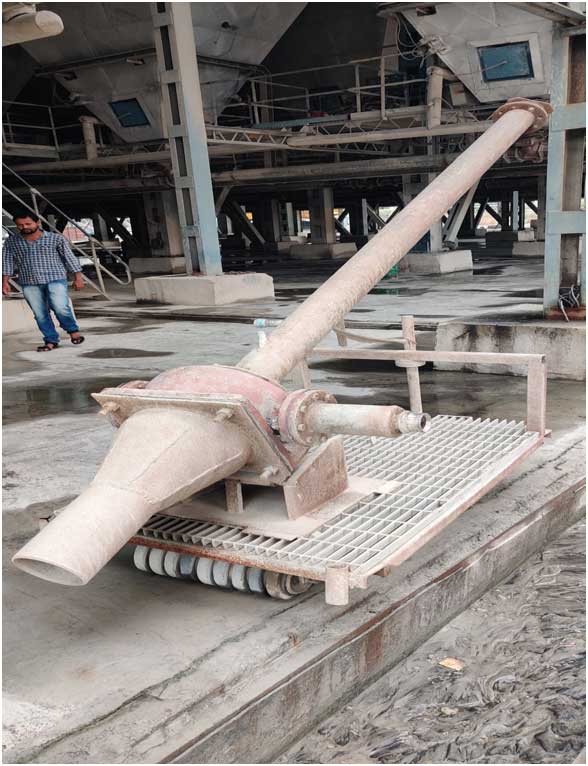Author: Phani Kumar, Divisional Engineer, KTPP-Stage-II, TS Genco
The 600 MW Kakatiya thermal power project (KTPP) in Telangana faced a lot of problem in ESP fly ash evacuation and conveying in 2017-18 due to water ingress in the ESP hoppers. During this period, the ESP major hoppers were overloaded with fly ash, causing damage to the hoppers. A new equipment, “Mobile wet feeder Ejector”, was installed for conveying fly ash in wet mode in order to safeguard the individual hoppers immediately. The following is a brief report and design features are about the mobile wet feeder ejector.
Background
Fly ash collected in the ESP hopper is evacuated to the buffer hopper and thereafter conveyed through air lock vessels to the SILOs for onward disposal to the cement plants and other utilities.
At the Kakatiya thermal power plant 600 MW (KTPP) situated in Telangana owned by TSGENCO, on an average, about 2,000 tonnes of fly ash per day is generated and is handled by the ash handling system through a vacuum pump of 400 MMWC capacity and transport compressors of 2.5 kg pressure. In ESPs, approximately 90 per cent of fly ash collected in the major hoppers is due to its self-weight. If the coal quality is poor, collection is more in the major fields and the hoppers build up fly ash within no time. Sometimes the fly ash is dumped on the floor to protect the hoppers.
Whenever ESP hoppers are loaded with fly ash and the dry system fails to empty the fly ash in hoppers, wet mode is used as an alternate method to evacuate fly ash. The arrangement for wet mode is either for all the hoppers or sometimes only limited to major fields. Generally, at the time of erection, ash handling is designed to provide wet mode as an alternate method for evacuating fly ash. However, at existing power plants, which do not have the wet mode, the mobile wet feeder ejector system can be utilized to evacuate in wet mode and safeguard the hoppers.
MWFE (Mobile Wet Feeder Ejector)
In KTPP/Stage-II (600 MW) a “Mobile wet ash feeder ejector” was developed and it is used to evacuate the individual ESP hoppers through wet mode. This ejector can be moved under the particular hopper wherever it requires unloading of fly ash.
The ejector has 80 NB/100 NB adjustable ash inlet pipe fitted to the discharge ejector through a water line fire adaptor for connecting 64 NB flexible fire hose of pressure 6 to 8 kg/cm2 and with a dummy to ensure vacuum. The ejector is moved on a trolley and any two persons can handle the system. The mobile wet feeder is connected to ESP poke dummy with fly ash connector flange. This can be customized as per the plant requirement.
Operation
The ejector is fitted to the poke dummy of the hopper and fitted with nuts and bolts with rubber seal to ensure no drop in the vacuum. Once the pipe is fitted to the hopper, fire water is injected through flexible hose with 7 to 8 kg/cm2 pressure to create vacuum in the line connected between hopper and ejector. Vacuum is ensured in the line through dummy connected above ejector. After confirmation of the vacuum, the ESP hopper extraction valve is opened and the fly ash is conveyed through the connected pipe line duly mixing with the water in ejector and transported to ash slurry sump.
This device is used for empty any particular hopper through wet mode at any time. In case of any major hopper overloaded with fly ash, this device can be moved under that particular hopper and can operate. The device made at the site with available spares with the skilled staff.
In case of non-availability of wet system in the existing plant, it is economical to have this mobile wet ejector instead of commissioning all the major hopper (first and second fields) for A, B, C, D passes. In case of emergency to unload the particular hopper, this ejector proves very helpful.
 Demo picture of Mobile Wet Ash Feeder Ejector
Demo picture of Mobile Wet Ash Feeder Ejector
 Mobile wet ash feeder ejector
Mobile wet ash feeder ejector
